3 Reasons Why You Need Chiropractic Care After You Been Injured in An Auto Accident
Nobody would like to be involved in an auto accident. Between other life challenges, adding a car accident to the mix just creates more things to think about and stress. In addition, auto accident injuries bring additional stress on your life thus making you unable to undertake certain tasks or take time off work.
One of the most common injuries from car accidents is whiplash. Whiplash happens when the head sustains a sudden, jerking movement forward, backward, or even to the side. It causes severe pain and destabilizes the spine along with the following indicators:
Neck pain
Arm pain
Low back pain
Headaches
Blurred vision
Neck stiffness
Reduced range of motion in the neck
Dizziness
The following are the top 3 reasons and justifications for seeking chiropractic care after a car accident:
If The Car Accident Was Extensive
Most people usually visit the hospital after an extensive car accident. Any time head injuries are involved or there is a likelihood of internal bleeding, it is important to seek emergency medical care.
If You Are In Pain
Pain after a car accident is a good indicator that you have an injury. In case there is a chance that life threatening or severe injuries are involved, it is good to visit the emergency room first to rule those out.
If You Have Seen A Specialist
Visiting the hospital is a great way of protecting your insurance rights but does not mean that injuries cannot be overlooked. If the hospital clears you of life threatening or serious injuries but are still experiencing pain, it is advisable to see a chiropractor.
It is important to seek chiropractic care after a car accident since the leaving the effects of whiplash to go untreated may induce long-term pain. The severity of physical effects of the accident are not apparent immediately following. It takes much time up to several weeks or months for major symptoms to show up. This is why chiropractic care is important to maintain the health of a spine that has been through trauma.
All body parts jarred or thrown forward beyond usual limits and unexpectedly can sustain tears or stretched ligaments. During a collision, those supporting the head and neck are particularly vulnerable to this type of tearing. Since chiropractors specialize in the care of muscles, bones, connective tissue, and nerves, it is important to visit one after an accident.
In conclusion, early care ensures quick realization of full healing. Even a car accident that seems minor with minimal damage to the car itself can cause the driver and its passengers serious injury. Chiropractic treatment is the right step in restoring the body. It makes necessary adjustments to the spine, relieves pain, and can include foam roller or massage techniques. Besides treatment, exercises to continue the healing by yourself and advice for optimal nutrition are some of the ways chiropractors offer holistic care for the individual after a car accident.
Tuesday, November 29, 2016
3 Reasons Why You Need Chiropractic Care After You Been Injured in An Auto Accident
Labels:
accident,
ache,
back,
car,
chiropractor,
crash,
headache,
information,
injury,
livonia,
migraine,
neck,
northville,
novi,
pain,
physical therapist,
plymouth,
rehabilitation,
traumatic,
treatment
Location:
Livonia, MI 48152, USA
Wednesday, November 23, 2016
Livonia Chiropractor, Triumph Chiropractic with Physical Therapist in Southfield on Local TV
Chiropractors and Physical Therapist on Ask The Chiropractor Show!
Labels:
accident,
ache,
back,
car,
chiropractor,
crash,
headache,
injury,
livonia,
migraine,
neck,
northville,
novi,
pain,
physical therapist,
plymouth,
rehabilitation,
traumatic,
treatment
Location:
Livonia, MI 48152, USA
Wednesday, September 21, 2016
What to do in case of an auto accident. Accident Injury spine specialist Livonia
Accidents Injuries and Whiplash
What to do in case of an auto accident.
Posted: September 21, 2016
By: Dr. Alexander Rodnick
- Stop immediately and remain as close to the location of the accident as possible. If no one is injured and vehicles can be moved to a safe location out of traffic, they should usually be moved.
- Check immediately for injured persons. if necessary, call a doctor or ambulance, whichever is quicker. Do not try to move the injured person.
- Warn approaching vehicles with emergency flashers, flares, reflectors, or even a flashlight.
- Notify the police, county, or state law officers at once. An official report may be helpful at a later time.
- You have the right to consult a lawyer as soon as you choose to. Do not comment on the accident. keep notes and information to yourself.
- Assist the officer. remain at the scene until the officer arrives, and advise the officers of the basic facts.
- Obtain the other driver's name, address, and vehicle registration number. Ask to see his or her driver's license.
- Obtain names, addresses, and telephone numbers of all witnesses. Ask witnesses to sign a statement.
- Make notes on all significant circumstances concerning the accident. If possible take pictures.
- Inform your insurance company. Make a complete report to your insurance carrier. Failure to make a prompt and correct report may affect your rights.
- See a Chiropractor. Serious and costly injuries do not always result in immediate pain or bloodshed. Aside from the more dramatic wounds which require surgery or hospitilization, other serious and costly injuries may result from auto accidents. A thorough examination by a Doctor of Chiropractic is a wise precaution to confirm the presence or absence of injuries. Doctors of Chiropractic are particularly well qualified to detect and treat a wide variety of injuries of the spine, nerves, and other related structures. Automobile liability and med pay insurance will normally pay for chiropractic examination and treatment. Your claim should be verified to check your coverages.
Saturday, September 17, 2016
pics of new office in livonia, triumph chiropractic, accident injury, spine specialist, chiropractor
Our beautiful waiting room
Examination room
Therapy room: traction equipment, exercise balls
3D Foot scanner for custom Orthotics
Relaxing spa atmosphere
waiting room / front desk
Intersegmental traction tables / roller massage and vibration
Whole body vibration platform
Massage therapy suite
Kids play area
Digital records for faster more accurate notes
top notch spine treatment facility
Digital X-ray for higher quality imaging
Omni Chiropractic adjusting tables
Open concept floor plan
Flexion-Distraction lumbar decompression
X-ray suite
Friday, April 29, 2016
headaches, migraines, neck pain, chiropractic northville, novi, livonia, plymouth, canton
If you are a headache sufferer you know how devastating headaches can be. They can shut you down completely. There are several types of headaches with many causes. There are also many treatments aimed at relieving the pain you feel. Some are designed to treat the symptoms while others are focused on correcting the cause. Chiropractic care is delivered to address the later. migraines, tension headaches, and even sinus headaches can all be cervicogenic, or caused from irritations to the nerves in the neck. I personally utilize multiple techniques in my office to remove nerve pressure and in turn correct the cause of many patients headaches. If you are a headache sufferer and have not been utilizing chiropractic care, you have been missing out. If you would like some more information on headaches and chiropractic care please feel free to contact my office or visit the wellness library online.

 Headaches
Headaches

 Headaches
Headaches
Labels:
accident,
ache,
back,
canton,
car,
chiropractor,
crash,
headache,
information,
injury,
livonia,
migraine,
neck,
northville,
novi,
pain,
plymouth,
traumatic
Location:
Northville, MI 48167, USA
Saturday, April 2, 2016
accident and whiplash cause neck pain! will it lead to arthritis and degeneration? correct it early on with chiropractic. Novi, Northville, Plymouth, Livonia
734-237-8916
Subluxation Degeneration
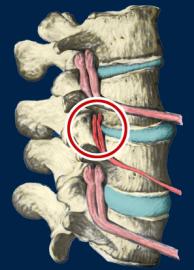 This is a representation of one type of subluxation. A subluxation, as defined by the Association of Chiropractic Colleges is: "A subluxation is a complex of functional and/or structural and/or pathological articular changes that compromise neural integrity and may influence organ system function and general health." When a subluxation occurs it causes nerve interference in some portion of the body affected by those nerves. The subluxation causes changes to the structure as well as the nerves. These changes get progressively worse as time is allowed to work on the subluxated area of the spine. These changes take the form of ongoing degeneration known as "subluxation degeneration". By understanding the type and amount of changes, it is possible to reasonably estimate the time subluxations have been present in a spine. Having this information is useful in understanding the time and effort needed for correction.
This is a representation of one type of subluxation. A subluxation, as defined by the Association of Chiropractic Colleges is: "A subluxation is a complex of functional and/or structural and/or pathological articular changes that compromise neural integrity and may influence organ system function and general health." When a subluxation occurs it causes nerve interference in some portion of the body affected by those nerves. The subluxation causes changes to the structure as well as the nerves. These changes get progressively worse as time is allowed to work on the subluxated area of the spine. These changes take the form of ongoing degeneration known as "subluxation degeneration". By understanding the type and amount of changes, it is possible to reasonably estimate the time subluxations have been present in a spine. Having this information is useful in understanding the time and effort needed for correction.Near Normal
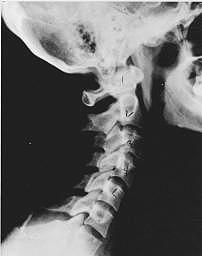 This is a side x-ray view of the neck. As with all the pictures you will see on this page, the patient is looking to the right of the screen, so you are viewing the right side of their neck. We will call this picture a "near normal" spine. Compare this spine with the ones you will see below on this page. Notice the normal forward curve of the neck. This curve helps absorb shock. Notice how each of the disc spaces between C2 (second bone in neck) and C7 are thick and even, this again is normal. Also notice how the front portions (right on the x-ray) of each of the vertebrae (called the 'body' of the vertebrae) are fairly square with clear and well defined borders. This type of arrangement is normal in the neck. Normal vertebrae in other parts of the spine also have similar characteristics to what we see here. When subluxations occur and are left uncorrected, ongoing relentless changes occur that result in damage to the structure and function of the spine along with nerve damage and the resulting problems caused from improper nerve supply.
This is a side x-ray view of the neck. As with all the pictures you will see on this page, the patient is looking to the right of the screen, so you are viewing the right side of their neck. We will call this picture a "near normal" spine. Compare this spine with the ones you will see below on this page. Notice the normal forward curve of the neck. This curve helps absorb shock. Notice how each of the disc spaces between C2 (second bone in neck) and C7 are thick and even, this again is normal. Also notice how the front portions (right on the x-ray) of each of the vertebrae (called the 'body' of the vertebrae) are fairly square with clear and well defined borders. This type of arrangement is normal in the neck. Normal vertebrae in other parts of the spine also have similar characteristics to what we see here. When subluxations occur and are left uncorrected, ongoing relentless changes occur that result in damage to the structure and function of the spine along with nerve damage and the resulting problems caused from improper nerve supply.Phase One - Subluxation Degeneration
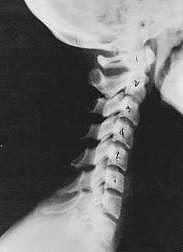 Phase One Subluxation Degeneration is seen in subluxations that have been present for up to twenty years. This phase is characterized with a loss or change in the normal curve in the spine. On this example you can see that the normal forward (lordotic) curve is lost. This spine even has developed a reverse curve in the neck. The disc spaces have also begun to exhibit a slight change in shape. One good point is that the bodies of each of the vertebrae (the square part in front) still exhibits clean clear borders. Segmental motion may be abnormal but overall motion is probably not affected. Chiropractic reconstructive care for a phase one can take from 6 to 18 months. More than 80% of people with Phase One Subluxation Degeneration have no pain. Therefore, if left uncorrected, phase one continues to progress with time until it eventually reaches the next phase.
Phase One Subluxation Degeneration is seen in subluxations that have been present for up to twenty years. This phase is characterized with a loss or change in the normal curve in the spine. On this example you can see that the normal forward (lordotic) curve is lost. This spine even has developed a reverse curve in the neck. The disc spaces have also begun to exhibit a slight change in shape. One good point is that the bodies of each of the vertebrae (the square part in front) still exhibits clean clear borders. Segmental motion may be abnormal but overall motion is probably not affected. Chiropractic reconstructive care for a phase one can take from 6 to 18 months. More than 80% of people with Phase One Subluxation Degeneration have no pain. Therefore, if left uncorrected, phase one continues to progress with time until it eventually reaches the next phase.Phase Two - Subluxation Degeneration
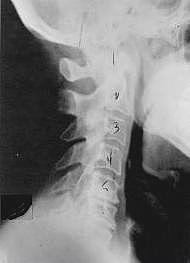 Phase two subluxation degeneration is normally seen in subluxations that have been present between 20 and 40 years. This phase has some of the same characteristics of the previous phase including a loss of normal curvature and position as well as an alteration in segmental motion. In addition, spines with Phase Two Subluxation Degeneration many times show a reduction in the patient's range of motion in that area. X-rays of a phase two begin to show calcium changes or buildup at certain levels of the spine. These changes are sometimes called by many names including spurs and arthritis. Disc spaces between the affected vertebrae are noticeably narrower and may appear to be flattening out. Although most people with Phase Two Subluxation Degeneration may not exhibit any symptoms, some may start to feel stiff or achy. Chiropractic reconstructive care for patients in phase two ranges from 1.5 years to 2.5 years. Again, if Phase Two Subluxation Degeneration is left uncorrected it slowly advances to the next phase.
Phase two subluxation degeneration is normally seen in subluxations that have been present between 20 and 40 years. This phase has some of the same characteristics of the previous phase including a loss of normal curvature and position as well as an alteration in segmental motion. In addition, spines with Phase Two Subluxation Degeneration many times show a reduction in the patient's range of motion in that area. X-rays of a phase two begin to show calcium changes or buildup at certain levels of the spine. These changes are sometimes called by many names including spurs and arthritis. Disc spaces between the affected vertebrae are noticeably narrower and may appear to be flattening out. Although most people with Phase Two Subluxation Degeneration may not exhibit any symptoms, some may start to feel stiff or achy. Chiropractic reconstructive care for patients in phase two ranges from 1.5 years to 2.5 years. Again, if Phase Two Subluxation Degeneration is left uncorrected it slowly advances to the next phase.Phase Three - Subluxation Degeneration
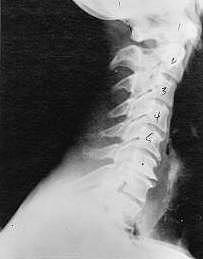 Phase Three Subluxation Degeneration is caused by subluxations that have been continuing on for between 40 and 65 years. This phase has all of the attributes of the previous phases, only worse. The curvatures are abnormal, the disc spaces are vastly decreased and changed. Calcium changes on the spine are abundant in this phase. Normally, people in phase three have a restricted range of motion and probably exhibit symptoms of some kind. In phase three the vertebrae show obvious changes and mutations in shape. Projections made of calcium, sometimes referred to as "spurs or lipping", can be readily seen on x-ray. Chiropractic reconstructive care for patients in phase three ranges from 2.5 years to 3.5 years. This does not mean that at the end of this time that any or all of the calcium changes will be gone. In many instances the body adapts to the presence of the calcium and positive changes can only be measured from a functional standpoint. As before, if Phase Three Subluxation Degeneration is left unchecked it slowly advances onward into the next phase.
Phase Three Subluxation Degeneration is caused by subluxations that have been continuing on for between 40 and 65 years. This phase has all of the attributes of the previous phases, only worse. The curvatures are abnormal, the disc spaces are vastly decreased and changed. Calcium changes on the spine are abundant in this phase. Normally, people in phase three have a restricted range of motion and probably exhibit symptoms of some kind. In phase three the vertebrae show obvious changes and mutations in shape. Projections made of calcium, sometimes referred to as "spurs or lipping", can be readily seen on x-ray. Chiropractic reconstructive care for patients in phase three ranges from 2.5 years to 3.5 years. This does not mean that at the end of this time that any or all of the calcium changes will be gone. In many instances the body adapts to the presence of the calcium and positive changes can only be measured from a functional standpoint. As before, if Phase Three Subluxation Degeneration is left unchecked it slowly advances onward into the next phase.Phase Four - Subluxation Degeneration
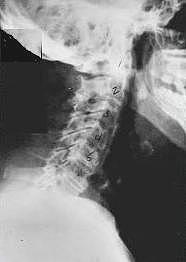 Phase four subluxation degeneration is seen with subluxations that have been raging on uncorrected or altered for over sixty five years. Phase four is a grave condition that will negatively affect the patients longevity and quality of life. The massive amount of neurological damage caused by years of subluxation that have lead to phase four are probably taking a serious toll on this person's health status. X-rays in phase four show serious severe structural changes. Vertebrae exhibit massive calcium changes, disc spaces appear blurred, and the bones themselves appear fused. In this scenario the patient will have a severe restriction of range of motion in addition to probably a number of other health issues. Reconstruction may not be possible in phase four, but care can be directed to some reduction in subluxation with the goal of improvement in the quality of life remaining. Patients in Phase Four Subluxation Degeneration have a serious situation both structurally and neurologically, but they are certainly not beyond hope. Many patients in phase four report significant improvements in symptoms, conditions, mobility and quality of life.
Phase four subluxation degeneration is seen with subluxations that have been raging on uncorrected or altered for over sixty five years. Phase four is a grave condition that will negatively affect the patients longevity and quality of life. The massive amount of neurological damage caused by years of subluxation that have lead to phase four are probably taking a serious toll on this person's health status. X-rays in phase four show serious severe structural changes. Vertebrae exhibit massive calcium changes, disc spaces appear blurred, and the bones themselves appear fused. In this scenario the patient will have a severe restriction of range of motion in addition to probably a number of other health issues. Reconstruction may not be possible in phase four, but care can be directed to some reduction in subluxation with the goal of improvement in the quality of life remaining. Patients in Phase Four Subluxation Degeneration have a serious situation both structurally and neurologically, but they are certainly not beyond hope. Many patients in phase four report significant improvements in symptoms, conditions, mobility and quality of life.
It should be noted that the above are common guidelines and not hard rules. Every person is dynamic and different. People degenerate at different rates and heal at different rates. The further along your spine may be with subluxation degeneration the more strenuous and time consuming your road to improvement will be. For this reason we always stress early care to stop and prevent the advancement of subluxation degeneration. Of course, if you're not under chiropractic care, the best time to start is NOW!
Labels:
accident,
ache,
back,
canton,
car,
chiropractor,
crash,
headache,
information,
injury,
livonia,
migraine,
neck,
northville,
novi,
pain,
plymouth,
traumatic,
treatment
Location:
Northville, MI 48167, USA
Wednesday, March 30, 2016
Chiropractic techniques and services at Triumph Chiropractic Northville
Chiropractic techniques and services at Triumph Chiropractic Northville
734-237-8916
Techniques
Since each and every individual is unique, the same adjustment is not used with everyone. At Triumph Chiropractic, a wide variety of chiropractic techniques are used. There are many factors one must consider while performing adjustments on a patients. One patient may require a light, low force technique, such as Activator or impulse. Other’s may need a full spine approach, in which a high velocity, low amplitude thrust is delivered and joint cavitation is obtained. Below is descriptions of the various Chiropractic techniques utilized in the office.
FULLSPINE & DIVERSIFIED
After a complete analysis, the Dr. Rodnick will deliver any necessary adjustments. The focus of a Diversified adjustment is to be as specific, precise and accurate as possible, addressing only the problem areas (areas of subluxation). Great care is taken to ensure a bio-mechanically correct position and precise thrust to provide the most accurate and painless adjustment possible. It is our goal to restore and maintain optimal health by locating and correcting any interference to the nervous system caused by vertebral subluxation.
Extremity Adjustments
A misalignment of a joint not only occurs in the spine, but can manifest in the extremities of the human body. An extremity adjustment can be performed on the TMJ, shoulders, elbows, wrist, knee, ankle and more. The adjustments can be used to reduce scar tissue, reduce tight muscles, help recover from an injury, re-educate the joint motion and restore normal function to the joint.
Activator
The Activator technique has published clinical and scientific peer-reviewed papers beyond that of most chiropractic analytical treatment procedures. The Activator is a mechanical low force, manually-assisted adjusting instrument is recognized and covered by insurance. It is safe and easy to use with patient of all ages.
THOMPSON TECHNIQUE
Thompson Technique uses an adjusting table with a pneumatically driven, segmented drop system, which quickly lowers the section of the patient’s body corresponding with the spinal region being adjusted. The doctor thrusts at high speed, using minimal force, because while the thrust initiates movement, the fast drop carries the joint through the remainder of its range of motion. Leg length checks, palpation, X-rays and other appropriate tests are used by the Thompson practitioner in determining where to adjust.
PREGNANCY CARE
Chiropractic care has yielded great results for decades in not only reducing back pain, but improving overall quality of life during ones pregnancy. When a women has the job of creating another life, pain should be the last thing affecting her nervous system. In addition to reducing pain, the Webster technique has shown positive resulting in promoting proper positioning of the baby for delivery.
COX FLEXION/DISTRACTION
Cox® Technique is research-documented spinal manipulation to relieve lower back pain, neck pain, arm pain, leg pain and a host of other spinal related conditions like disc herniation, spinal stenosis, post-surgical continued pain, and pregnancy related back pain. Cox® Technic’s developer, Dr. James M. Cox, has insisted for nearly 50 years on documenting the science of this non-surgical alternative to back surgery approach to back pain relief in the hands of well-trained back specialists.
Labels:
accident,
ache,
back,
canton,
car,
chiropractor,
crash,
headache,
information,
injury,
livonia,
migraine,
neck,
northville,
novi,
pain,
plymouth,
traumatic,
treatment
Location:
Wayne County, MI, USA
Subscribe to:
Comments (Atom)



















